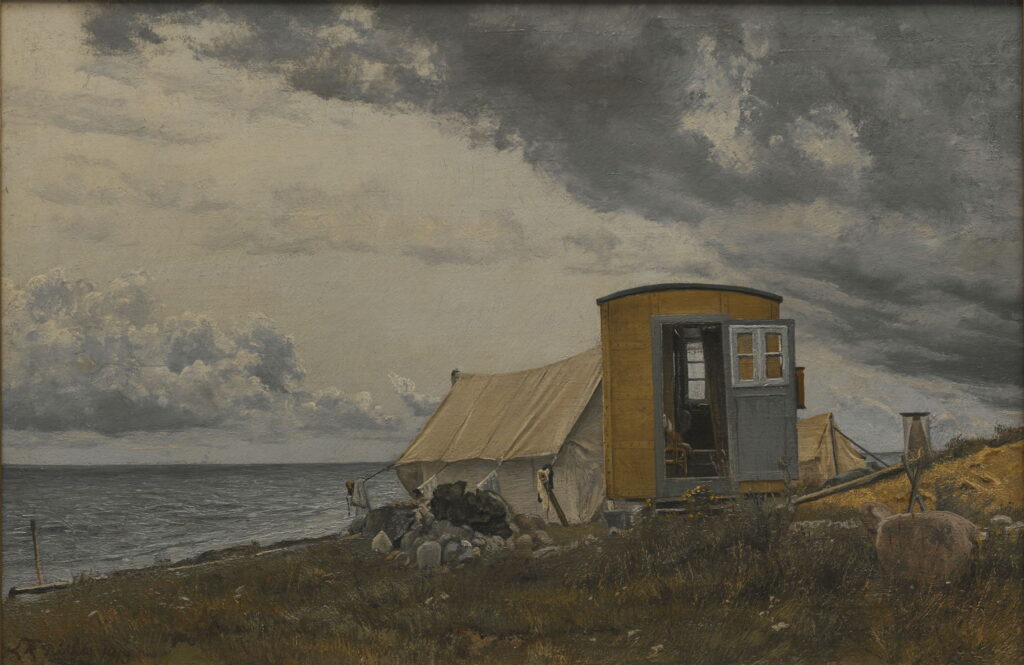Paintings by a Baltic Beach 2

On this the second day of our visit to the coast of the Baltic Sea, I show paintings from the late nineteenth century until well after the First World War. Following their early popularity with Caspar David Friedrich and German Romantic painters, a new generation saw this region in a different light.
Lovis Corinth was born in the town of Tapiau near what was then the city of Königsberg, and is now in the Russian exclave of Kaliningrad, on the eastern coast of the Baltic Sea.
Lovis Corinth (1858–1925), Cemetery in Nidden (1893), oil on canvas, 112 × 148 cm, Neue Pinakothek, Munich. Wikipedia Commons.
Corinth’s painting shows the beautiful fishermen’s Cemetery in Nidden (1893) on the Kurische Nehrung, a long sand spit near the southern border of Lithuania, on the shore of the Baltic not far from Königsberg.
Lovis Corinth (1858–1925), Swimming in Horst – Ostsee (1902), oil on canvas, dimensions not known, Museum Georg Schäfer, Schweinfurt, Bavaria. Wikimedia Commons.
His later painting of Swimming in Horst – Ostsee from 1902 shows swimmers in the Baltic Sea at what was then known as Horst, and is now the Polish resort of Niechorze.
Lovis Corinth (1858–1925), Paddling (1902), oil on canvas, 83 x 60 cm, Niedersächsisches Landesmuseum Hannover, Hanover. Wikimedia Commons.
Paddling, from the same year, shows his partner Charlotte Berend taking her turn in the waters there. The following Spring, when he was 44 and she was only 22, they married.
Laurits Andersen Ring acquired his last name from the town on the Danish island of Sjælland (Zealand) where he was born. Later in his career he moved to the tiny rural island of Enø, linked to Sjælland by a bridge at Karrebæksminde.
Laurits Andersen Ring (1854–1933), The Artist’s Wife with the Family Caravan (1911), oil on canvas, 39.5 x 60.5 cm, Statsministeriet, Copenhagen, Denmark. Wikimedia Commons.
By 1911, Ring and his family had bought a caravan, which in those days resembled a railway goods wagon and usually weighed several tons. Most had to be towed by a truck or even a traction engine, which were still used on farms, and were barely mobile. The Artist’s Wife with the Family Caravan (1911) shows his wife Sigrid in a loose-fitting dress, under the shade of a parasol, enjoying a holiday amid sand dunes, somewhere on the Danish Baltic coast.
Laurits Andersen Ring (1854–1933), The Bridge at Karrebæksminde (1912), oil on canvas, 69.5 x 132 cm, Statsministeriet, Copenhagen, Denmark. Wikimedia Commons.
The Bridge at Karrebæksminde from 1912 must be one of Ring’s most intricately detailed works, showing the bridge connecting the large and populous island of Sjælland with tiny Enø. This canal was dug in the early nineteenth century to connect Karrebæk Fjord with the waters of the Baltic, and has a strong tidal stream, as demonstrated here.
Laurits Andersen Ring (1854–1933), View of a Shore with the Artist’s Wagon and Tent at Enö (1913), oil on canvas, 40 x 61 cm, Nationalmuseum, Stockholm, Sweden. Wikimedia Commons.
In the summer of 1913 Ring and his family holidayed again in their caravan. In his View of a Shore with the Artist’s Wagon and Tent at Enö, they are seen on the south-west coast of the island of Enø. They have spilled out into a tent, whose heavy guy ropes are being used to dry washing.
Ants Laikmaa (1866–1942), Landscape with a Farm (Saaremaa Landscape) (1914), pastel on paper, dimensions not known, Eesti Kunstimuuseum, Tallinn, Estonia. Wikimedia Commons.
The Estonian pastellist Ants Laikmaa painted this Landscape with a Farm or Saaremaa Landscape in 1914. Saaremaa is the largest island in Estonia, and lies off its western coast, in the Baltic Sea. Laikmaa’s view is almost tropical, with this semi-derelict farm standing in deep serenity near the water’s edge.
Karl Isakson (1878–1922), Graveyard, Christiansø (1911-13), oil on canvas, 56 x 66 cm, Bornholm Art Museum, Bornholm, Denmark. Wikimedia Commons.
In 1911, Karl Isakson visited the small Baltic island of Christiansø, near the larger and more populous Bornholm, the easternmost parts of Denmark. Graveyard, Christiansø from 1911-13 shows the island’s small cemetery.
Karl Isakson (1878–1922), View over Gudhjem (1921), oil on canvas, 76 x 92 cm, location not known. Wikimedia Commons.
During the First World War, Isakson was unable to visit Christiansø, so spent much of his time on the nearby and larger island of Bornholm, where he painted its landscape. View over Gudhjem (1921) shows this small fishing town on its north coast.



